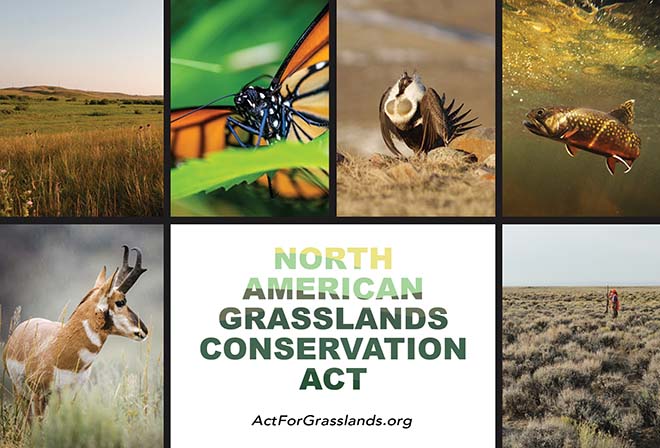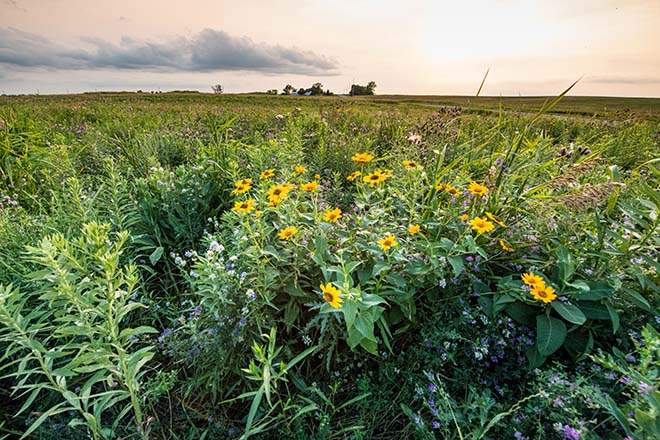Photos by Aaron Black-Schmidt
The climate policy discussion is an opportunity for Pheasants Forever and Quail Forever to advance our upland habitat mission
Part 3 of a 3-Part Series
By Bethany Erb and Jim Inglis
In the Summer and Fall 2021 issues of The Journal of Upland Conservation, we outlined why Pheasants Forever and Quail Forever has chosen to engage in climate policy. We also shared the science behind why grasslands function so well as a carbon capture tool while helping build ecological and economic resiliency across the country.
In this final installment of our series, we will explain what federal polices Pheasants Forever and Quail Forever are working on as part of the climate/carbon policy discussion and the political process ahead.
The fact is, we’ve always engaged in climate policy and have always supported voluntary private lands conservation programs that sequester carbon.
For years PF & QF have advocated for Farm Bill conservation programs that offer numerous environmental benefits, including demonstrated carbon capture. The North American Wetlands Conservation Act (NAWCA) among other programs is critical for wildlife habitat; and the conserved wetlands capture and store carbon.
In today’s political environment, we’re talking about those programs differently. But in sincerity, when it comes to climate policy, Pheasants Forever and Quail Forever are just doing what we’ve always done and highlighting an additional set of benefits.
Pheasants Forever and Quail Forever believe that two programs are a critical part of the climate discussion: the Conservation Reserve Program (CRP), and our proposed North American Grasslands Conservation Act.
The article Brightest Sunlight to Darkest Soil that ran in the Fall Issue of this journal explained why deep-rooted grass ecosystems are incredible at carbon capture.
Enacting policy in Washington D.C. is all about timing. Every day our government affairs team assesses the landscape by reviewing committee hearings and floor votes, then talking and meeting with Congressional staff. We share information with our trusted partners and evaluate the competing circumstances, most of which arise unexpectedly.
The policy landscape tends to shift often and is rarely straightforward. Know this: When our team asks you for your help communicating with legislators, it is very much needed. When we ask our dedicated volunteers to make a call or write an email, we do not take it lightly. We only ask for your help when we are at an inflection point — a point where your phone call or email can move the needle for wildlife and for natural resource conservation.
For example, in September 2021, PF & QF along with our coalition conservation partner organizations issued a call-to-action. Our goal was to raise the awareness to Congress of the need for a North American Grasslands Conservation Act.

Collectively PF & QF members and those of our partners sent nearly 50,000 emails to their elected officials. That’s right, 50,000! The results were astounding. Congressional staff called us, sent emails and texted back wanting to know more about the initiative and how they could be involved.
Thank you! That is more than moving the needle. It is making (good) waves for upland habitat, conservation and wildlife.
Since its inception in 1985, CRP has been the cornerstone of PF & QF’s advocacy. We were at the table then, and we have continued to improve the benefits of the program. From reducing soil erosion, improving water quality, and supporting practices and legislation that directly impact pheasant and quail populations, we have helped lead those efforts.
CRP has, and will continue to be, part of the environmental, ecologic and economic safety net in rural America. It is well documented that when an acre of CRP is created, it will hold the soil with its root systems, improve water quality by filtering sediment and nutrients before they reach our water courses, provide cover and food for numerous species of wildlife, provide forage for domestic livestock annually, and yes, sequester carbon deep into the soil.
Even though these benefits have been well documented over CRP’s 35 years, there are some who believe that maintained or expanded CRP is not part of the answer for wildlife and carbon. There are those who believe that CRP should be drastically reduced or eliminated altogether.
Pheasants Forever and Quail Forever are currently experiencing this impression especially in practices that create larger blocks of wildlife habitat that are critical for upland birds. Countering this argument, leading with science-based evidence will be our charge as we begin the debate in the next two years, as the Farm Bill will need to be reauthorized in the fall of 2023.

Our vision for a North American Grasslands Conservation Act would create a new program administered at the Department of Interior, providing $350 million per year for a NAWCA-like (North American Wetlands Conservation Act) grasslands program. Grants would be available for landowners that voluntarily wish to conserve their lands. Grants would range from creating and enhancing wildlife habitat to removing invasive species and providing voluntary easements that could support farmers, ranchers and landowners.
The Grasslands Act has not yet been introduced but your engagement in early fall, described above, brought us a step closer. We currently have members of Congress interested in drafting the bill. That bill will need to be bipartisan, introduced by both Democrats and Republicans, in both the House and the Senate. Following introduction, co-sponsor recruitment will begin. The more co-sponsors a bill has, the better its odds of receiving a committee hearing and progressing to the next step.
A winding road awaits us for both CRP and the Grasslands Act. Conservation is a long-term game, and we will continue to need your support at every turn.
Visit
quailforever.org/conservationpolicy often for all the news on Quail Forever’s critical policy work in Washington D.C. and across the county for upland wildlife habitat and grasslands policy.
Bethany Erb and Jim Inglis comprise Pheasants Forever’s government affairs team.
This story originally appeared in the 2022 Winter Issue of the Pheasants Forever Journal. If you enjoyed it and would like to be the first to read more great upland content like this, become a Pheasants Forever member today!